Hey folks!
A little late on this week's blog, but here it is! Today's topic: two tools to track Twitter tweets, TweetDeck and Monitter!
Last summer, I worked as a marketing intern for
Bopomo Pictures, where I worked directly with the owner, Elayne Wandler. She was considering creating a blog for the studio, but wasn't really sure of what types of things to put in it. One of my assignments was to generate a list of potential topics that would interest her target market--mainly, families with small children.
Thus, my Twitter account was born! I used it to follow a number of accounts which I felt would be useful in helping me learn the type of things mothers would be interested in (ex.
YummyMummyClub,
UrbanMommies, etc). You can just imagine how difficult it was to monitor all these groups, on top of following other accounts I was personally interested in! Knowing that Elayne managed Bopomo's Twitter account, I asked her for some advice, and she recommended TweetDeck.
TweetDeck is a real-time monitoring tool which allows the user to segment his or her followees(?) into groups, @replies, direct messages, and more. I was able to separate tweets from my friends, celebrities, and Bopomo-related users into different columns, making life--and my job--easier! TweetDeck also lets you to set up custom searches that alert you whenever something appears that matches your criteria. The only negative thing I can think of about TweetDeck is that it is limited to 10 columns. Since I only ever used five at the most, I'd say TweetDeck is a pretty sweet (tweet) way to monitor your Twitter account!
The second monitoring tool I believe everyone should know about is
Monitter. To be honest, I only found out about it in yesterday's e-Marketing class when we were discussing Search. Monitter is similar to Twitter in that is segregates real-time tweets into columns, except in this case, the segmentation is based on keywords you type into the search box on top of each column. Monitter allows you to use up to three columns at once. Unlike TweetDeck, Monitter monitors virtually all the Twitter accounts in the world, instead of just the people you follow, making it a pretty powerful tool for your business!
Of all the potential uses for Monitter, the best one for me would probably be for customer feedback. By typing the name of your brand, your competitors' brands, or even just the general product category, you can see what people truly think of your product and what they use it for. It is pretty much a goldmine of improvement opportunities! I only wish I knew about Monitter when I was still working for Bopomo. I would have been able to search for people interested in looking for high-quality, affordable photo shoots, and inform them about our studio. Should I get a similar job in the future, I will definitely be taking advantage of this tool!
That's it for today's blog! I am sure you have already heard of these tools in some way or another, but here is just some honest feedback from a simple Marketing student! :)
Mae















